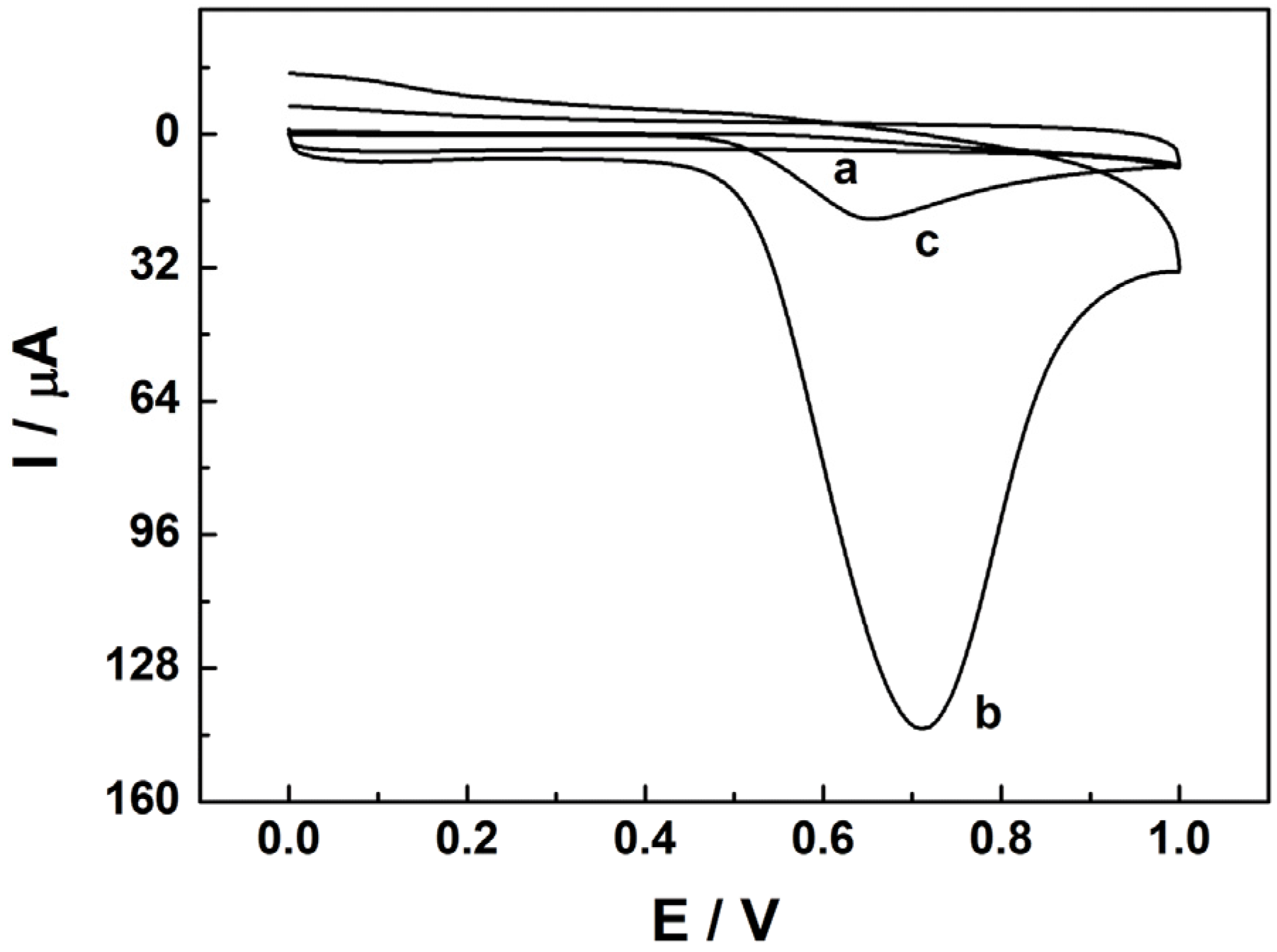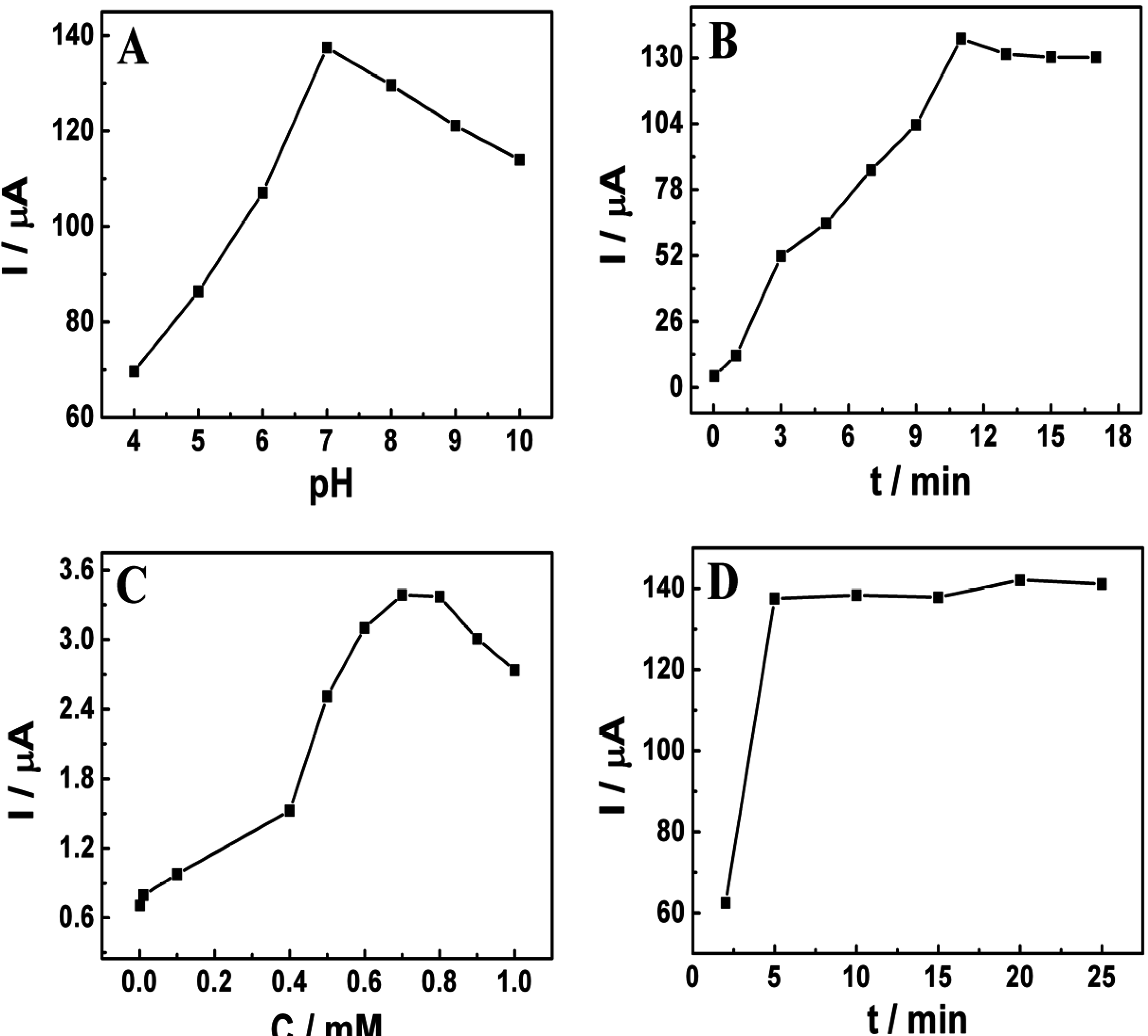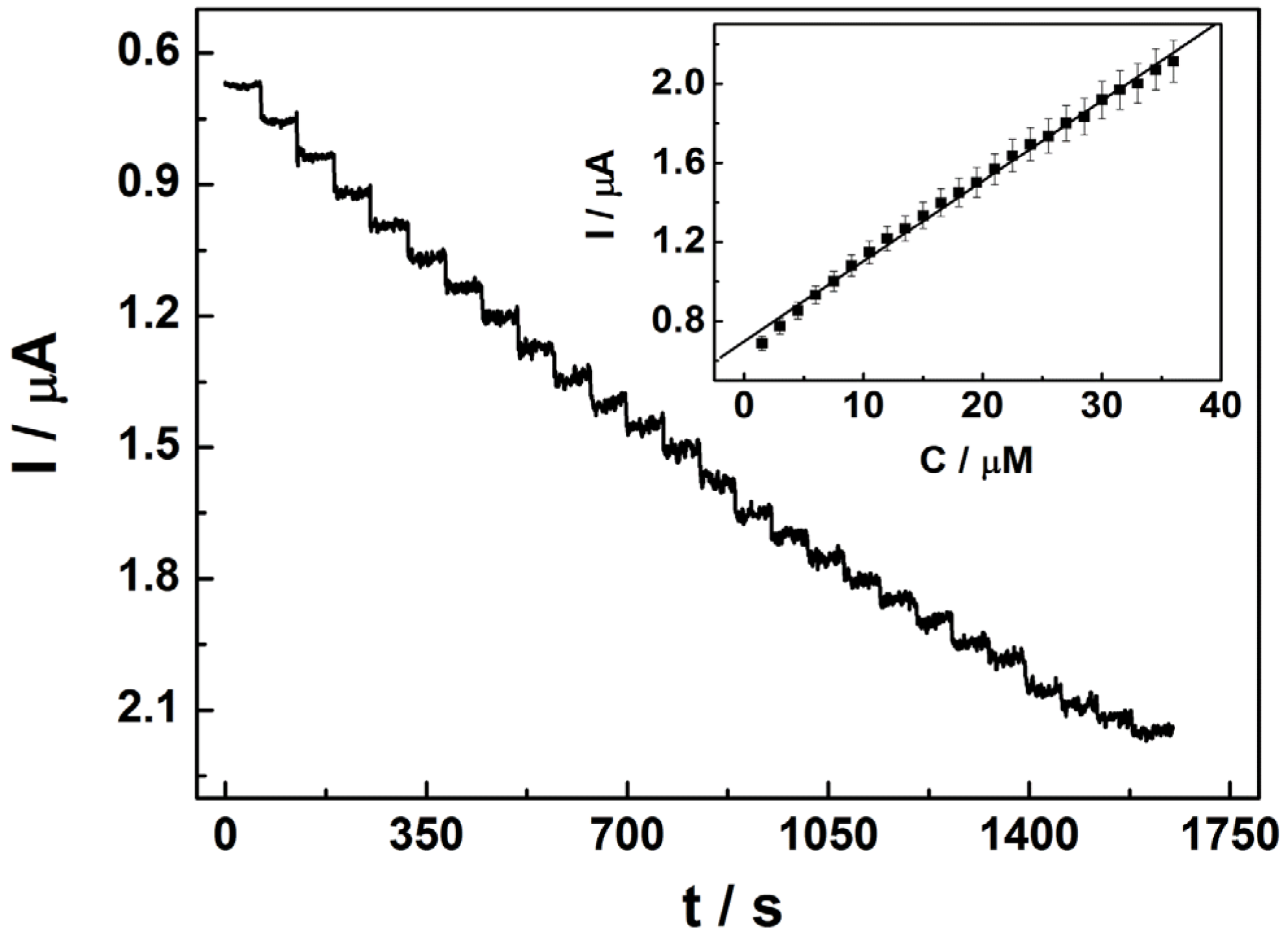A Facile Electrochemical Sensor for Nonylphenol Determination Based on the Enhancement Effect of Cetyltrimethylammonium Bromide
Abstract
:1. Introduction
2. Experimental Section
2.1. Reagents and Chemicals
2.2. Preparation of the Modified Electrode
2.3. Instruments
2.4. Preparation of Real Sample
3. Results and Discussion
3.1. Cyclic Voltammetric Behavior of NP
3.2. Optimization of NP Detection at the CTAB/CP Electrode
3.3. Detection of NP at the CTAB/CP Electrode
3.4. Amperometric Response of NP at the CTAB/CP Electrode
3.5. Stability, Reproducibility and Interferences of the Sensor
3.6. Real Sample Analysis
4. Conclusions
Acknowledgments
References
- Frassinetti, S.; Barberio, C.; Caltavuturo, L.; Fava, F.; Di Gioia, D. Genotoxicity of 4-nonylphenol and nonylphenol ethoxylate mixtures by the use of Saccharomyces cerevisiae D7 mutation assay and use of this text to evaluate the efficiency of biodegradation treatments. Ecotox. Environ. Saf. 2011, 74, 253–258. [Google Scholar]
- Mota, L.C.; Barfield, C.; Hernandez, J.P.; Baldwin, W.S. Nonylphenol-mediated CYP induction is PXR-dependent: The use of humanized mice and human hepatocytes suggests that hPXR is less sensitive than mouse PXR to nonylphenol treatment. Toxicol. Appl. Pharmacol. 2011, 252, 259–267. [Google Scholar]
- Kwak, H.I.; Bae, M.O.; Lee, M.H.; Lee, Y.S.; Lee, B.J.; Kang, K.S.; Chae, C.H.; Sung, H.J.; Shin, J.S.; Kim, J.H.; et al. Effects of nonylphenol, bisphenol A, and their mixture on the viviparous swordtail fish (Xiphophorus helleri). Environ. Toxicol. Chem. 2001, 20, 787–795. [Google Scholar]
- Liu, X.; Tani, A.; Kimbara, K.; Kawai, F. Metabolic pathway of xenoestrogenic short ethoxy chain-nonylphenol to nonylphenol by aerobic bacteria, Ensifer sp. strain AS08 and Pseudomonas sp. strain AS90. Appl. Microbiol. Biotechnol. 2006, 72, 552–559. [Google Scholar]
- De Weert, J.P.A.; Viñas, M.; Grotenhuis, T.; Rijnaarts, H.H.M.; Langenhoff, A.A.M. Degradation of 4-n-nonylphenol under nitrate reducing conditions. Biodegradation 2011, 22, 175–187. [Google Scholar]
- Casajuana, N.; Lacorte, S. New methodology for the determination of phthalate esters, bisphenol A, bisphenol A diglycidyl ether, and nonylphenol in commercial whole milk samples. J. Agric. Food Chem. 2004, 52, 3702–3707. [Google Scholar]
- Wu, J.; Wang, F.; Gong, Y.; Li, D.; Sha, J.; Huang, X.; Han, X. Proteomic analysis of changes induced by nonylphenol in Sprague-Dawley rat Sertoli cells. Chem. Res. Toxicol. 2009, 22, 668–675. [Google Scholar]
- Arslan, O.; Parlak, H. Embryotoxic effects of nonylphenol and octylphenol in sea urchin Arbacia lixula. Ecotoxicology 2007, 16, 439–444. [Google Scholar]
- Kim, Y.J.; Yun, H.J.; Ryu, J.C. Expression profiling of estrogen responsive genes on bisphenol A, 4-nonylphenol and 17β-estradiol treatment using in house cDNA microarray. Biochip J. 2011, 5, 86–94. [Google Scholar]
- Raecker, T.; Thiele, B.; Boehme, R.M.; Guenther, K. Endocrine disrupting nonyl- and octylphenol in infant food in Germany: Considerable daily intake of nonylphenol for babies. Chemosphere 2011, 82, 1533–1540. [Google Scholar]
- Danzo, B.J. Environmental xenobiotics may disrupt normal endocrine function by interfering with the binding of physiological ligands to steroid receptors and binding proteins. Environ. Health. Perspect. 1997, 105, 294–301. [Google Scholar]
- Kloas, W.; Lutz, I.; Einspanier, R. Amphibians as a model to study endocrine disruptors: II. Estrogenic activity of environmental chemicals in vitro and in vivo. Sci. Total Environ. 1999, 225, 59–68. [Google Scholar]
- Hill, M.; Stabile, C.; Steffen, L.K.; Hill, A. Toxic effects of endocrine disrupters on freshwater sponges: Common developmental abnormalities. Environ. Pollut. 2002, 117, 295–300. [Google Scholar]
- Madsen, S.S.; Skovbølling, S.; Nielsen, C.; Korsgaard, B. 17-β Estradiol and 4-nonylphenol delay smolt development and downstream migration in Atlantic salmon. Salmo salar. Aquat. Toxicol. 2004, 68, 109–120. [Google Scholar]
- Latorre, A.; Lacorte, S.; Barceló, D.; Montury, M. Determination of nonylphenol and octylphenol in paper by microwave-assisted extraction coupled to headspace solid-phase microextraction and gas chromatography-mass spectrometry. J. Chromatogr. A 2005, 1065, 251–256. [Google Scholar]
- Park, J.W.; Kurosawa, S.; Aizawa, H.; Goda, Y.; Takai, M.; Ishihara, K. Piezoelectric immunosensor for bisphenol A based on signal enhancing step with 2-methacrolyloxyethyl phosphorylcholine polymeric nanoparticle. Analyst 2006, 131, 155–162. [Google Scholar]
- Núñez, L.; Turiel, E.; Tadeo, J.L. Determination of nonylphenol and nonylphenol ethoxylates in environmental solid samples by ultrasonic-assisted extraction and high performance liquid chromatography-fluorescence detection. J. Chromatogr. A 2007, 1146, 157–163. [Google Scholar]
- Céspedes, R.; Skryjová, K.; Raková, M.; Zeravik, J.; Fránek, M.; Lacorte, S.; Barceló, D. Validation of an enzyme-linked immunosorbent assay (ELISA) for the determination of 4-nonylphenol and octylphenol in surface water samples by LC-ESI-MS. Talanta 2006, 70, 745–751. [Google Scholar]
- Huang, J.; Zhang, X.; Liu, S.; Lin, Q.; He, X.; Xing, X.; Lian, W.; Tang, D. Development of molecularly imprinted electrochemical sensor with titanium oxide and gold nanomaterials enhanced technique for determination of 4-nonylphenol. Sens. Actuators B Chem. 2011, 152, 292–298. [Google Scholar]
- Hu, C.; Hu, S. Electrochemical characterization of cetyltrimethyl ammonium bromide modified carbon paste electrode and the application in the immobilization of DNA. Electrochim. Acta 2004, 49, 405–412. [Google Scholar]
- Hu, S.; Wu, K.; Yi, H.; Cui, D. Voltammetric behavior and determination of estrogens at Nafion-modified glassy carbon electrode in the presence of cetyltrimethylammonium bromide. Anal. Chim. Acta 2002, 464, 209–216. [Google Scholar]
- Lu, Q.; Hu, C.; Cui, R.; Hu, S. Direct electron transfer of hemoglobin founded on electron tunneling of CTAB monolayer. J. Phys. Chem. B 2007, 111, 9808–9813. [Google Scholar]
- Yin, H.S.; Zhou, Y.L.; Ai, S.Y. Preparation and characteristic of cobalt phthalocyanine modified carbon paste electrode for bisphenol A detection. J. Electroanal. Chem. 2009, 626, 80–88. [Google Scholar]
- Laviron, E. General expression of the linear potential sweep voltammogram in the case of diffusionless electrochemical systems. J. Electroanal. Chem. Interfacial Electrochem. 1979, 101, 19–28. [Google Scholar]
- Kuramitz, H.; Saitoh, J.; Hattori, T.; Tanaka, S. Electrochemical removal of p-nonylphenol from dilute solutions using a carbon fiber anode. Water Res. 2002, 36, 3323–3329. [Google Scholar]
- Kim, Y.S.; Katase, T.; Sekine, S.; Inoue, T.; Makino, M.; Uchiyama, T.; Fujimoto, Y.; Yamashita, N. Variation in estrogenic activity among fractions of a commercial nonylphenol by high performance liquid chromatography. Chemosphere 2004, 54, 1127–1134. [Google Scholar]
- Liu, X.; Feng, H.; Liu, X.; Wong, D.K.Y. Electrocatalytic detection of phenolic estrogenic compounds at NiTPPS/carbon nanotube composite electrodes. Anal. Chim. Acta 2011, 689, 212–218. [Google Scholar]
- Evtugyn, G.A.; Eremin, S.A.; Shaljamova, R.P.; Ismagilova, A.R.; Budnikov, H.C. Amperometric immunosensor for nonylphenol determination based on peroxidase indicating reaction. Biosens. Bioelectron. 2006, 22, 56–62. [Google Scholar]




| Interferents | Concentration (M) | Signal change (%) |
|---|---|---|
| Ca2+ | 2 × 10−3 | 1.6 |
| Cu2+ | 1 × 10−3 | −2.7 |
| Cl− | 2 × 10−3 | 2.0 |
| NO3− | 2 × 10−3 | −4.9 |
| SDS a | 1 × 10−4 | −3.1 |
| Spain 60 | 1 × 10−4 | 2.2 |
| DTAB b | 1 × 10−4 | −2.8 |
| Dopamine | 1 × 10−4 | −3.0 |
| Ascorbic acid | 1 × 10−4 | 2.9 |
| Bisphenol A | 1 × 10−4 | 5.2 |
| Sample | Added (μM) | Found (μM) | Recovery (%) |
|---|---|---|---|
| Sample 1 | 5 | 4.85 | 97.0 |
| Sample 2 | 7.5 | 8.20 | 109.3 |
| Sample 3 | 10 | 10.84 | 108.4 |
| Sample 4 | 15 | 15.84 | 105.6 |
© 2013 by the authors; licensee MDPI, Basel, Switzerland. This article is an open access article distributed under the terms and conditions of the Creative Commons Attribution license (http://creativecommons.org/licenses/by/3.0/).
Share and Cite
Lu, Q.; Zhang, W.; Wang, Z.; Yu, G.; Yuan, Y.; Zhou, Y. A Facile Electrochemical Sensor for Nonylphenol Determination Based on the Enhancement Effect of Cetyltrimethylammonium Bromide. Sensors 2013, 13, 758-768. https://doi.org/10.3390/s130100758
Lu Q, Zhang W, Wang Z, Yu G, Yuan Y, Zhou Y. A Facile Electrochemical Sensor for Nonylphenol Determination Based on the Enhancement Effect of Cetyltrimethylammonium Bromide. Sensors. 2013; 13(1):758-768. https://doi.org/10.3390/s130100758
Chicago/Turabian StyleLu, Qing, Weina Zhang, Zhihui Wang, Guangxia Yu, Yuan Yuan, and Yikai Zhou. 2013. "A Facile Electrochemical Sensor for Nonylphenol Determination Based on the Enhancement Effect of Cetyltrimethylammonium Bromide" Sensors 13, no. 1: 758-768. https://doi.org/10.3390/s130100758




